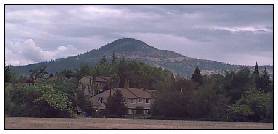
 Medford Station 4: From Bedrock to Lava Rock
Medford Station 4: From Bedrock to Lava Rock
THE MASSIVE ROCK spreading across the creek bed is sandstone. This sand and gravel was deposited from rivers rushing from the early Klamath-Siskiyou range some 37 million years ago. With time, the gravel and sand became cemented together to form sedimentary rocks. This vein of sandstone is called the Payne Cliff Formation and extends through the Bear Creek Valley. Because sandstone is softer, and therefore erodes faster than the metamorphic Klamath-Sikkiyous to the south, or the volcanic Cascades to the north, the ancestral Bear Creek carved the valley we now see through the less resistant sedimentary rocks.Turn around and you will get a good look at Roxy Ann, an eroded knob of lava resting on a band of Payne Cliff sandstone.

This may also be a good place to view some of the birds that frequent Bear Creek and its ponds; mallards are the most common. Their presence provides an opportunity to observe the courtship behavior that starts in the fall and culminates with breeding in the spring: nodding, when a mallard swims rapidly for a short distance with its head stretched out just above the water; and pumping, when a male and female face each other and rhythmically bob their heads up and down. The beautiful plumage of the wood ducks makes them distinctive and easy to identify. Wood ducks do not quack, but produce a variety of high pitched whistles. Wood ducks make their nests in the tree cavities high above the water; ducklings must make a long jump to find water. Their light weight and heavy layer of feathers cushion the fall. Look for the nest boxes placed along the Greenway to replace nest trees that have been lost.
Large numbers of migrating Canada geese winter in the bigger ponds and pastures along Bear Creek.
